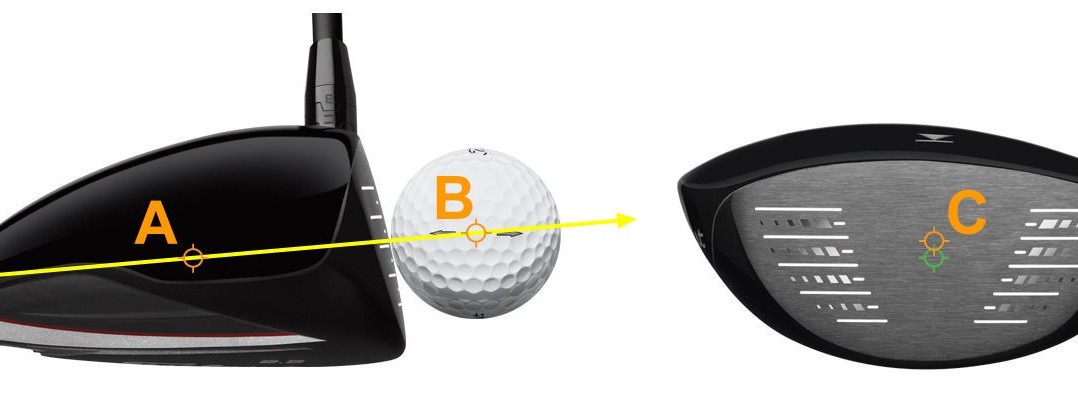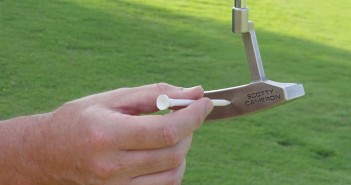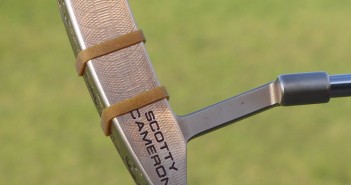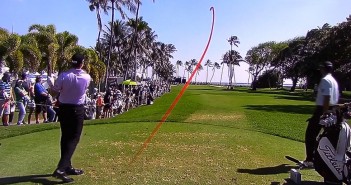The “sweet spot” of a golf club is one of the misused terms in the golf industry. Equipment manufacturers regularly tell us that their new clubs have a “larger sweet spot”, but this just isn’t true! Understanding why will help you to develop a better understanding of how your golf clubs work, and how to use them more effectively.
What is the Sweet Spot?
Let’s start by making one thing absolutely clear. The sweet spot of any golf club is a point on the club face that is no bigger than the sharp end of a pin. Nothing that equipment manufacturers do can ever make it bigger.
This is because the sweet spot is nothing to do with the design of the golf club, as such. Instead, it’s the exact point on the face where, when you strike a golf ball, the centre of gravity (CoG) of the club head is moving directly towards the CoG of the golf ball. Both CoGs are exact points, infinitely small, so the sweet spot is equally small.
The reason that this spot is “sweet” is that, when the CoG of the club head is moving directly towards the CoG of the golf ball at impact, this provides the optimal energy transfer from the club head to the ball.
If you strike the ball with the sweet spot of the club, with a square club face and path, the ball will fly straight and true, and the ball will travel the maximum distance that your golf swing will allow. Similarly, when you are shaping the shot, playing a draw or a fade, by altering the club head path relative to the face angle, you will always get maximal distance and control by striking the ball with the sweet spot.
Missing the Sweet Spot
When you strike the ball away from the sweet spot, then the energy transferred to the ball will be reduced, and some of the available energy will be diverted towards changing the spin characteristics of the golf ball – you will lose distance.
The further away from the sweet spot that you strike the ball, the less efficient the energy transfer becomes. As a general rule, if you strike the ball at a point on the club face that is only about 1” (2.5cm) from the sweet spot, you will lose approximately 10% of your distance – about 20 yards with the driver, for the average golfer.
When you strike the ball off centre, away from the direction of the CoG of the club head, this causes the club head to twist during impact, reducing the efficiency of the energy transfer to the ball even further, and creating something called “gear effect”.
Gear effect is when the twisting club head changes the spin axis of the golf ball – when the club head twists in a clockwise direction, the club face behaves much like the cogs of a gear, tilting the spin axis of the ball so that the ball spin is more counter clockwise, and vice versa. So when a right handed golfer hits the ball off the toe of the club, the club head will twist clockwise, causing the ball to spin more counter clockwise. In other words, a toe hit (even a slight one) creates draw spin, and striking the ball towards the heel of the club will create fade spin.
Similarly, striking the ball higher on the club face will create less backspin on the ball, and lower on the face will create more backspin (topspin is impossible with anything like a normal strike).
Much more on the gear effect to come in another article.
The Sweet Spot is Dynamic
Something that very few golfers realise is that the sweet spot of a golf club is not a fixed point, it moves depending on the precise impact dynamics of each strike.
This phenomenon is only really relevant with larger-headed clubs, such as the driver, where the CoG of the club head is set back away from the club face.
In Figure 1, we illustrate a driver striking the ball with a zero angle of attack – the club head is moving horizontally, directly towards the ball at impact. The CoG of the club head (A) is moving directly towards the CoG of the golf ball (B) when the club face strikes the ball at point (C). Under these impact conditions, the sweet spot of the club face is point (C), representing the best place on the club face to strike the ball for optimal energy transfer to the golf ball.
Figure 1. Driver sweet spot for zero angle of attack.
In Figure 2, we look at a similar impact, but with a +5 degree angle of attack – the club head is moving upwards as it strikes the ball – these are approximately the optimal impact conditions for most golfers who are looking for maximum distance, see Golf Swing 109 – Setup: How to Set Up for the Driver in the Golf Swing.
Figure 2. Driver sweet spot for +5 degree angle of attack.
Here, you can see that, in order to create conditions where the CoG of the club head is moving directly towards the GoG of the golf ball, for optimal ball striking efficiency, we need to strike the ball a little higher on the club face – about ⅓” (8.5mm) higher. In Figure 2, the original sweet spot for a zero attack angle is shown in green, and the new sweet spot in orange at point (C).
The same phenomenon occurs with an “in to out” or “out to in” club head path through impact. An inside attack, used to produce a draw, will move the sweet spot slightly out towards the toe. A fade swing will move the sweet spot slightly towards the heel.
In all cases, the deviation of the sweet spot is very small. If your path or attack angle are extreme, the spot would move more but it could never be described as “sweet”. Significant differences between the club head path and the face angle will always lead to an inefficient strike – it’s a “glancing blow” that will spin the ball significantly left or right, and greatly reduce your distance.
Making the Sweet Spot “Bigger”
As we’ve already explained, it’s not possible to create a bigger sweet spot.
It is, however, possible to reduce the amount of energy lost due to an imperfect strike, which is what manufacturers are really talking about when they describe “larger” sweet spots.
Moment of Inertia
This is what club manufacturers are mostly referring to when they talk about a “more forgiving” golf club.
The first thing that club designers try to do, to maximise the efficiency of the strike for an off-centre hit, is to make the club head more resistant to twisting during impact. They do this by distributing more weight out on the perimeter of the club head, and further back in the head, to increase its moment of inertia (MOI). A higher MOI means the club will twist less during an off-centre strike. Energy will still be lost, and the spin axis of the ball will still be effected, but less so.
Think of a figure skater doing a spin. When their arms are outstretched, they spin more slowly. They have distributed more of their weight outwards, and they are more “resistant” to spinning – they have increased their MOI.
This technique is taken to the extreme in so-called “game improvement” clubs, aimed at higher handicappers who struggle to strike the ball consistently. At the other end of the spectrum, bladed “muscle back” clubs have hardly any MOI technology, and the slightest mishit will twist the club face.
All players can benefit from this technology – very few Tour professionals use bladed clubs these days – but better players don’t like extreme MOI because it reduces the “feel” of the club. As a Golf Loopy student, working on improving your ball striking, it’s beneficial if you can clearly feel it when you find the sweet spot, and when you get strong feedback from the club about the degree that you mishit the ball when you do. You can’t improve effectively without good feedback, and lower MOI will give you better feedback (but, until you do improve, maybe higher scores!)
The other reason that better players don’t like “game improvement” clubs, especially irons, is that, in an effort to generate extra distance as well as forgiveness, these clubs tend to have “hot spots” on the club face. A good golfer needs to know that his 8-iron carries, for example, 164 yards with a good strike. If “forgiveness” technology means that it might carry somewhere between 140 and 180 yards, it’s useless.
As an aside, when you hear people saying that more bladed clubs help golfers to “work” the ball more, this is largely nonsense. The ball will react the same when hit with any golf club with the same impact dynamics – so hitting draws and fades on demand is the same with any club head design. The only place that this makes any difference is with hitting a low, penetrating, ball flight, which is more difficult with “game improvement” clubs where the weight is kept very low in the head to promote a higher ball flight – to help higher handicappers get the ball in the air.
Variable Thickness Face
This is what club manufacturers are referring to when they talk about a “bigger sweet spot”, and it also makes a golf club more “forgiving”.
Manufacturers use various technologies to change the “springiness” (the coefficient of restitution, COR) of the club face at varying points away from the “sweet spot” centre.
Essentially, they are trying to make the face a little thicker in the centre of the face, and thinner in outer areas of the face. Off-centre hits will flex the face more, increasing the effective COR, and thus increasing the amount of energy transferred to the golf ball.
Using these techniques, they are able to improve the efficiency of off-centre strikes significantly, leading to less loss of distance.
Face Bulge
With larger headed clubs, such as drivers, fairways woods and hybrids, manufacturers are able to make the whole club face slightly rounded outwards, slightly “domed”.
This means that when you strike the ball towards the toe, say, thus creating draw spin as the face twists, the part of the face where the strike occurs is pointing slightly right (for a right-handed club), so the ball will start right and then curve left. If the face were flat, the ball would hook more, but having the “face bulge” is more likely to result in a less damaging draw. Similarly with hits out of the heel, which will tend towards a fade more than a destructive slice.
All of these technologies, however, can never fully compensate for a poor strike. To play better golf, you must improve the quality of your ball striking, which means consistently hitting the ball very close to the sweet spot.
To do this, you need a simple, efficient and repeatable swing that works in harmony with biomechanics and physics – and there is no better way to achieve this than by learning the Swing like a Champion system.
And once you have a consistently good swing, get properly fitted for golf clubs. A good professional club fitter (probably not the guys in your local golf store) will fit you for clubs with the correct combination of length, lie, loft, swing weight and shaft profile for your swing, that will give you the best chance of finding the sweet spot consistently. That’s 20 extra yards over the average off-the-shelf clubs.
One final point on technology, don’t be seduced by manufacturer’s claims that longer shafts will help you hit the ball further. There are now a huge number of drivers that come with a 46” shaft as standard, which is just plain crazy! Yes, a bigger arc means more swing speed, but it also makes it impossible for mere mortals to find the sweet spot consistently. The best players in the world (including the longest hitters on Tour) use 44½” driver shafts, so should you.
Are You Finding the Sweet Spot?
When you’re working to build a great golf swing, you need good feedback about how close to the sweet spot you are striking the ball. As we described above, most clubs have a certain amount of forgiveness built in, which is a good thing, but it reduces the quality of this feedback. So how can we determine the quality of our ball striking?
One great way to see where on the club face you are striking the ball, as you practise, is to spray the face with Scholl foot powder, or the equivalent. When you strike the ball, it will leave a clear mark in the powder coating the club face.
Another similar trick is to paint the back of the ball with a dry-erase marker, and the strike will leave ink on the club face which clearly indicates impact. You can also purchase special film that you place on the club face that indicates the strike in a similar way.
Not only do these methods tell you where on the face you struck the ball, they also give you valuable information about the quality of the strike. When you strike the ball well, with a square club face and path, it will compress the ball more against the face during impact – so the bigger the impression made on the face by the ball, the better the strike.
As your golf swing improves, the impact marks will become larger and more tightly grouped, centred on the sweet spot, and wild mishits will become very rare. Your ultimate goal is to strike the ball on precisely the same point on the club face, the sweet spot, every time.
Happy fairways!

» The Mechanics of Golf Ball Flight.






